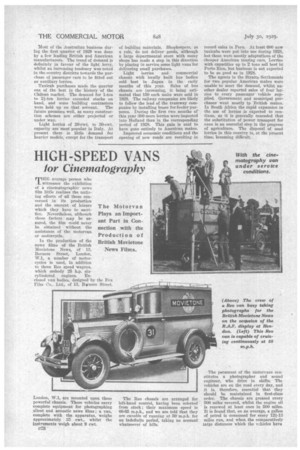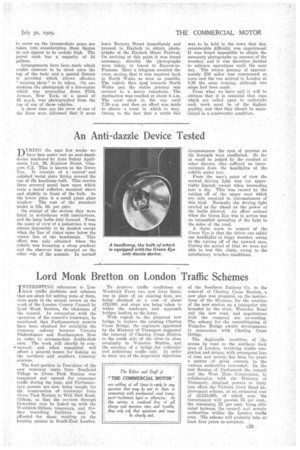HIGH-SPEED VANS
Page 50

Page 51

If you've noticed an error in this article please click here to report it so we can fix it.
for Cinematography
MBE average person who
witnesses the exhibition of a cinematographic news film little realizes the untiring efforts of all those concerned in its production and the amount of leisure which they have to sacrifice. Nevertheless, although those factors may be assured, the film could never he obtained without the assistance of the motorvan or motorcycle.
In the production of the news films of the British Movietone News, of 13, Deniers Street, London, W.1, a number of motorcycles is used, in addition to three Reo speed wagons, which embody 25 h.p. sixcylindered engines. Enclosed van bodies, designed by the Fox Film no.. Ltd., of 13, Earners Street, London, W.1, are mounted upon these powerful chassis. These vehicles carry complete equipment for photographing ,silent and acoustic news films ; a -van, complete with the apparatus, weighs approximately 35 cwt., whilst the instruments weigh about 9 cwt.
The Reo chassis are arranged for left-hand control, having been selected from stock ; their maximum speed is 60-65 m.p.h., and we are told that they are canahle of running at 50-m.p.h. for an indefinite period, taking no account whatsoever of hills.
The personnel of the motarvans constitutes a photographer and sound engineer, who drive in shifts. Tht vehicles are on the road every day, and it is, therefore, essential that they should be maintained in first-class order. The chassis are greased every 500 miles covered, whilst the engine oil is renewed at least once in 500 miles. It is found that, on an average, a gallon of petrol is consumed for every 123-13 miles run, and when the comparatively large distances which the vehicles have to cover on, the intermediate gears are taken into consideration these figures do not appear to be unduly high. The petrol tank has a capacity of 14 gallons.
Arrangements have been made which enable cameras to be stood upon the top of the body and a special fitment is provided which allows effective "running slots" to be taken. On one occasion the photograph of a fire-engine which was proceeding down Fifth Avenue, New York, at a speed of 45 m.p.h. was phcitographe.3 from the top of one of these vehicles.
A short time ago the crew of one of the Reos were informed that it must leave Berners Street immediately and proceed to Harlech to obtain photographs of the Harlech Music Festival. On arriving at this point it was found necessary, directly the photographs were taken, to travel to Barrow-inFurness. Here a telegram awaited the crew, stating that it was required back in North Wales as soon as possible. The vehicle then spe4 towards North Wales and the entire journey was covered in a heavy rainstorm. The destination was reached at about 4 a.m. The crew slept in the van until 7.30 a.m. and then an effort was made to obtain a room in which to stay. Owing to the fact that a cattle fair was to be held in the town that day, considerable difficulty was experienced. It was found impossible to obtain the necessary photographs on account of the weather, and it was therefore decided • to adjourn operations until the next day. The return journey of approximately 250 miles was commenced at noon and the van arrived in London at 8.30 the same evening, although two stops had been made.
From what we have said it will be obvious that it is essential that vans which are called upon to undertake such work must be of the highest Duality, and that they should be maintained in a roadworthy condition.












































































































